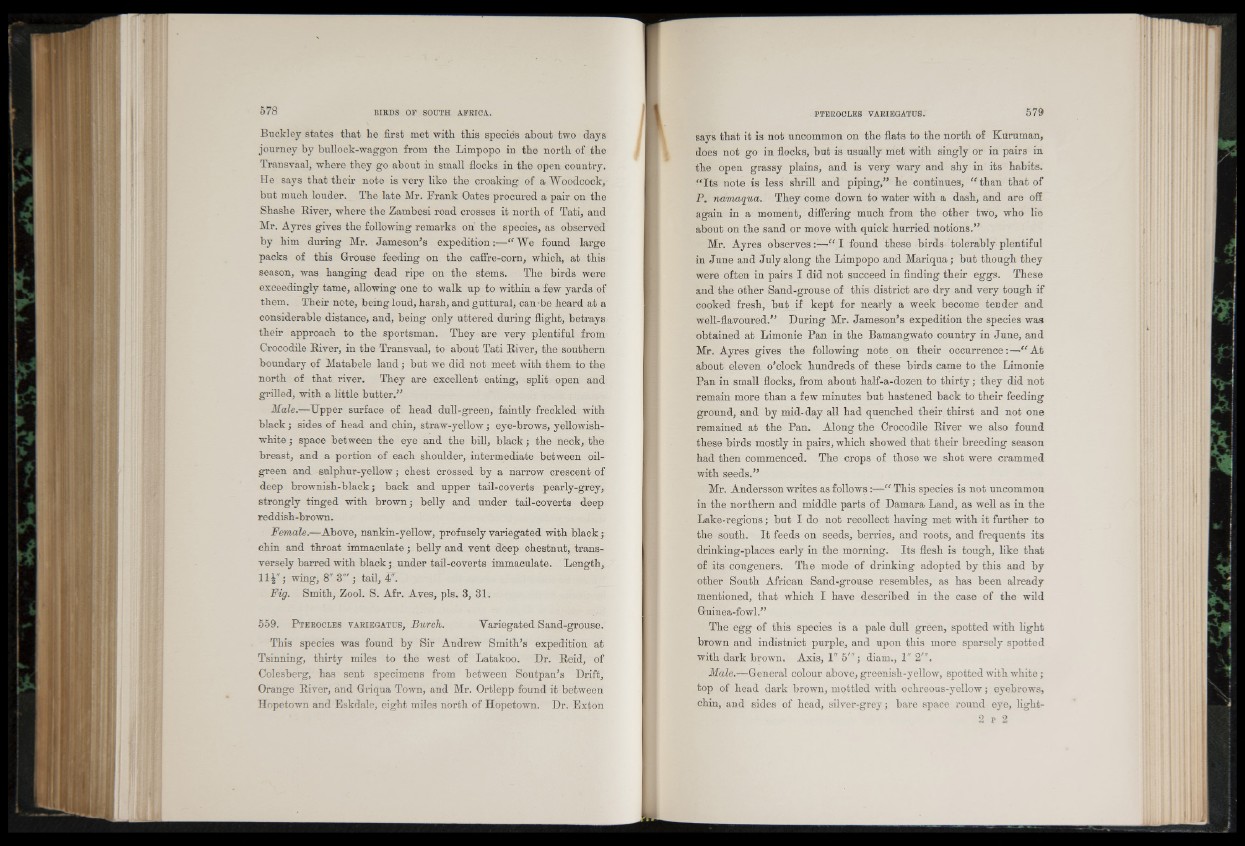
Buckley states that he first met with this species about two days
journey by bullock-waggon from the Limpopo in the north of the
Transvaal, where they go about in small flocks in the open country.
He says that their note is very like the croaking of a Woodcock;
but much louder. The late Mr. Frank Oates procured a pair on the
Shashe River; where the Zambesi road crosses it north of Tati; and
Mr. Ayres gives the following remarks on the species, as observed
by him during Mr. Jameson’s expedition:—“ We found large
packs of this Grouse feeding on the caffre-corn, which, at this
season, was hanging dead ripe on the stems. The birds were
exceedingly tame, allowing one to walk up to within a few yards of
them. Their note, being loud, harsh, and guttural, can-be heard at a
considerable distance, and, being only uttered during flight, betrays
their approach to the sportsman. They are very plentiful from
Crocodile River, in the Transvaal, to about Tati River, the southern
boundary of Matabele land; but we did not meet with them to the
north of that river. They are excellent eating, split open and
grilled, with a little butter.”
Male.—Upper surface of head dull-green, faintly freckled with
black; sides of head and chin, straw-yellow; eye-brows, yellowish-
white ; space between the eye and the bill, black; the neck, the
breast, and a portion of each shoulder, intermediate between oil-
green and sulphur-yellow; chest crossed by a narrow crescent of
deep brownish-black; back and upper tail-coverts pearly-grey,
strongly tinged with brown; belly and under tail-coverts deep
reddish-brown.
Female.—Above, nankin-yellow, profusely variegated with black;
chin and throat immaculate; belly and vent deep chestnut, transversely
barred with black; under tail-coverts immaculate. Length,
11|"; wing, 8" 3"'; tail, 4".
Fig. Smith, Zool. S. Afr. Aves, pis. 3, 31.
559. P t e r o c l e s v a r ie g a t u s , Burch. Yariegated Sand-grouse.
This species was found by Sir Andrew Smith’s expedition at
Tsinning, thirty miles to the west of Latakoo. Dr. Reid, of
Colesberg, has sent specimens from between Soutpan’s Drift,
Orange River, and Griqua Town, and Mr. Ortlepp found it between
Hopetown and Eskdale, eight miles north of Hopetown. Dr. Exton
says that it is not uncommon on the flats to the north of Kuruman,
does not go in flocks, but is usually met with singly or in pairs in
the open grassy plains, and is very wary and shy in its habits.
“ Its note is less shrill and piping,” he continues, “ than that of
P. namaqua. They come down to water with a dash, and are off
again in a moment, differing much from the other two, who lie
about on the sand or move with quick hurried notions.”
Mr. Ayres o b s e r v e s I found these birds tolerably plentiful
in June and July along the Limpopo and Mariqua; but though they
were often in pairs I did not succeed in finding their eggs. These
and the other Sand-grouse of this district are dry and very tough if
cooked fresh, but if kept for nearly a week become tender and
well-flavoured.” During Mr. Jameson’s expedition the species was
obtained at Limonie Pan in the Bamangwato country in June, and
Mr. Ayres gives the following note on their occurrence:—“ At
about eleven o’clock hundreds of these birds came to the Limonie
Pan in small flocks, from about half-a-dozen to thirty; they did not
remain more than a few minutes but hastened back to their feeding
ground, and by mid-day all had quenched their thirst and not one
remained at the Pan. Along the Crocodile River we also found
these birds mostly in pairs, which showed that their breeding season
had then commenced. The crops of those we shot were crammed
with seeds.”
Mr. Andersson writes as follows:—“ This species is not uncommon
in the northern and middle parts of Damara Land, as well as in the
Lake-regions; but I do not recollect having met with it further to
the south. It feeds on seeds, berries, and roots, and frequents its
drinking-places early in the morning. Its flesh is tough, like that
of its congeners. The mode of drinking adopted by this and by
other South African Sand-grouse resembles, as has been already
mentioned, that which I have described in the case of the wild
Guinea-fowl.”
The egg of this species is a pale dull green, spotted with light
brown and indistnict purple, and upon this more sparsely spotted
with dark brown. Axis, 1" 5"'; diam., 1" 2'".
Male.—General colour above, greenish-yellow, spotted with white;
top of head dark brown, mottled with ochreous-yellow; eyebrows,
chin, and sides of head, silver-grey; bare space round eye, light-
2 p 2